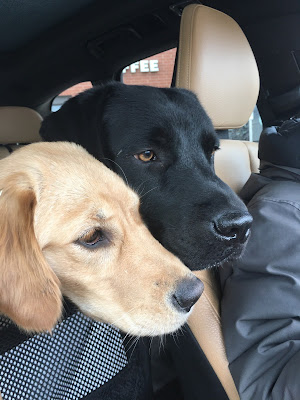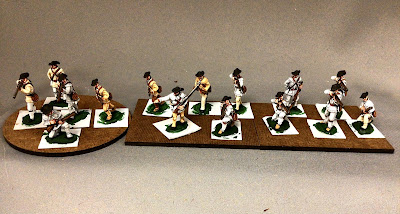 |
| Bella The Brain (left) and Augie The Brawn (right) cook up their plan for The Great Escape. |
Dogs often come across as silly and goofy and you never know what they are going to do to amuse you. Today, Bella the Brain and Augie the Brawn devised a cunning plan for their escape in the parking lot of Sunset Foods grocery store. They got the better of Fritz and Mrs. Fritz, who were bailed out of a potential disaster by the timely intervention of some bystanders in the parking lot.
Our story starts innocently enough, with Mrs. Fritz and me taking the royal hounds for a perambulation in the local forest preserve. We returned to our SUV after the walk and bundled the hounds into the back seat of the vehicle. There is a cargo area behind the back seat and this will come into play later in the story. We removed the harnesses and leashes from the hounds’ torsos for safety reasons once they are back in the vehicle. Dogs can get their leashes caught on some part of the seat and choke, so we remove the equipment once they are in the car.
You can probably see where this is leading.
So we are now in the car and I’m pointing the vehicle in the direction of home when Mrs. Fritz says to me, “ what do you want for dinner tonight?”
“What do we have at home?” I inquire.
“Chicken” she replies.
“What kind of chicken?” Says I.
“Frozen chicken” says Mrs. Fritz.
Well that doesn’t sound like a very good plan so I propose that we stop at the nearby Sunset Foods grocery store. The spouse agrees so off we go to the grocery store. In my concentration on the road while driving, I fail to notice the mischievous little wink that The Brain makes to The Brawn. There’s trouble on the horizon.
We pull into the parking lot and I volunteer to go inside to do the grocery shopping while Mrs. Fritz minds the hounds. It doesn’t occur to me to wonder whether or not she is up to the task of matching wits with The Brain. So I go into the store to buy the groceries while Mrs Fritz remains in the car checking her email on her smart phone.
The Brain makes a knowing nod of her head to The Brawn and the plans for The Great Escape are set in motion. I buy the groceries and return to the SUV with the grocery bags in the shopping cart. Escape plan Wack-A-Mole has just been launched. The Brain motions the Brawn to climb over the back seat and take up an ambush position in the cargo area. Their plan is cunningly simple. When Fritz opens the rear hatch door to put the groceries in the cargo hold, The Brawn will lunge towards Fritz whilst he is holding a grocery bag. The Brain will then jump over the back seat and escape out the hatch while I’m trying to grab The Brawn’s collar with my free hand (with grocery bag in the other hand).
The Wack-A-Mole plan seemingly works to perfection as Fritz has to decide whether to hold onto the shopping bag and one hound while the other jumps out the door; or drop the grocery bag and attempt to grab both dogs before they can effect their escape. Alas, it looks like the Great Escape will be foiled before it gets off the ground because Fritz didn’t pick up a shopping bag until he opened the rear hatch door. Thus Fritz has both hands available to apprehend the hounds.
I’m admittedly surprised to see the massive body of The Brawn in my face as I lift the hatch door. The Brain’s timing is a second slow and I’m able to grab both dog collars. Escape plan foiled? No. I call out for help and Mrs. Fritz bounds out of the front seat of the SUV at record speed and she grabs the collar of The Brawn while I’ve got The Brain on ice.
Then I make my big mistake. I try to push The Brawn over the seat back to put him in the back seat, but a momentary second is all that The Brain needs to escape my grasp and jump to freedom. Mrs. Fritz compounds my mistake by making one of her own: she turns around to head off the cute puppy known as The Brain thereby leaving a gaping hole in our defensive line. The Brawn overpowered me and leaped from the cargo area and on to the pavement. Then it’s a foot race and the humans are no match for the canines.
Suddenly it’s pandemonium in the parking lot of Sunset Foods as The Brain and The Brawn split off in different directions. The Brawn makes like Usain Bolt and he is off to the races. The Brain however, now makes a mistake as her Golden Retriever instincts take over and she makes a beeline to the nearest human that is not Mr or Mrs Fritz, and cuddles up between the legs of a bystander, seeking a belly rub. Apprended! Or so it seems.
I race over to the Bystander who says, “what an adorable dog” and I say “Thank You” , grab The Brain by the collar and usher her back to our vehicle. I open the side passenger door and cram The Brain into the back seat. Then I scan the parking lot for signs of Mrs. Fritz or The Brawn. Another Bystander somehow nabbed The Brawn and Mrs. Fritz is screaming, “Augie’s slipped out of his collar. Help!”
Now the beautifully choreographed Wack-A-Mole plan becomes apparent to the humans. Now that I’m distracted by The Brawn’s attempt to slip from the grasp of Mrs. Fritz and the Bystander, The Brain climbs over the back seat. I’ve forgotten to close the back hatch lid. The Brain bounds out the rear door and is back in the parking lot.
You think that you have one hound under control while the other hound is slipping from your grasp. You nab the first one and now the second one re-escapes. Wack-A-Mole.
I make one final lunge for The Brain and my luck turns for the better as I’m able to grab her by the collar. Mrs. Fritz is still frantic about The Brawn not having his collar on anymore. I’ve got The Brain in my left hand and with my right hand I grasp The Brawn’s leash and fling it towards Mrs. Fritz. This time I remember to close the back hatch door and push The Brain into the back seat of the Paddy Wagon.
Now that one dog is back in the car, two people can get The Brawn under control and herd him back into the car. The hounds admit defeat and settle into the back seat of our SUV. With things seemingly under control again, I gingerly reopen the back hatch door, no hounds in the cargo area this time, and I put the grocery bags in and shut the door again.
Mission accomplished! However, it was a near run thing as The Brain's plan Wack-A-Mole nearly succeeded. A long time ago I recall one of my friends telling me that all dogs live for one of two things: food or the chance to escape.
The Great Escape caper came to a close and we drove home. I was so undone that I had to make a stop at Starbucks and get a comfort Mocha Frappicino to calm my nerves.






























